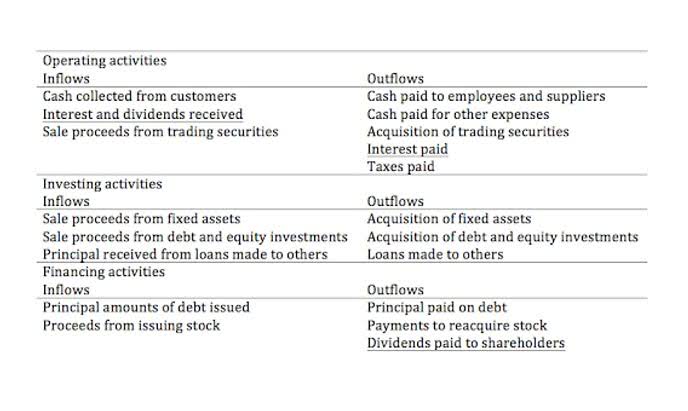
An investor must sell their shares at their choosing to redeem the shares. Cumulative preferred stocks allow the accumulation of noncumulative preferred stock dividends until they are paid. It provides a right to claim dividends of the specific amount which would be received each year.
- Though the mechanism is different, the end result is ongoing payments derived from an investment.
- Company XYZ announces dividends of $3.50/share to be paid in 2017, 2018, and 2019.
- More often than not, this feature is not at the election of the holder and is instead mandatory.
- Preferred stock occupies a middle ground between bonds and common stock.
- The Fund is subject to the risk that geopolitical events will disrupt securities markets and adversely affect global economies and markets.
How to Calculate Dividends for Cumulative Preferred Stock
- Some preferred stock are convertible, meaning they can be exchanged for a given number of common shares under certain circumstances.
- Participatory preference shares provide an additional profit guarantee to shareholders.
- Unlike common stockholders, preferred stockholders have limited rights, which usually does not include voting.
- In the event of the company’s liquidation or bankruptcy, non-cumulative preferred stockholders have a higher priority claim on the company’s assets than common stockholders.
- She has held multiple finance and banking classes for business schools and communities.
- Value at Risk is used to measure just how much is expected to be lost resulting from an investment over a period of time.
- Non-cumulative preferred stocks are high-risk stocks that are not entitled to any missed unpaid dividends.
So non-cumulative dividends can be missed without penalty, whereas cumulative dividends can be missed, but must be paid out later. However, the company cannot pay a dividend to holders of common stock until it has made holders of its preferred stock whole. One of the biggest differences between bonds and preferred stock, though, is that dividend payments on preferred stock can be deferred. A company must pay the interest on its bonds when it is due or they can be declared in default.
- Adam Hayes, Ph.D., CFA, is a financial writer with 15+ years Wall Street experience as a derivatives trader.
- If the issuer starts making its regularly scheduled preferred dividend payments again, it only has to become current and can then start paying common-stock dividends as well if it wishes.
- The existence of a fiduciary duty does not prevent the rise of potential conflicts of interest.
- However, their prices do reflect the general market factors that affect their issuers to a greater degree than the same issuer’s bonds.
- Convertible preferred stock usually has predefined guidance on how many shares of common stock it can be exchanged for.
- Our writing and editorial staff are a team of experts holding advanced financial designations and have written for most major financial media publications.
- Holders of non-cumulative preferred shares, on the other hand, have no right to receive past dividends should the company begin to issue dividends again.
Understanding Preference Shares
The motivation for the redemption is generally the same as for bonds—a company calls in securities that pay higher rates than what the market is currently offering. Also, as is the case with bonds, the redemption price may be at a premium to par to enhance the preferred’s initial marketability. Perpetual preferred stock is a type of preferred stock that pays a fixed dividend to investors for as long as the company remains in business. It does not have a maturity, nor a specific buyback date but does typically have redemption features.
par value dividend dividend number of preferred annual
Thomas J Catalano is a CFP and Registered Investment Adviser with the state of South Carolina, where he launched his own financial advisory firm in 2018. Thomas’ experience gives him expertise in a variety of areas including investments, retirement, insurance, and financial planning. Transparency is how we protect the integrity of our work and keep empowering investors to achieve their goals and dreams. And we have unwavering standards for how we keep that integrity intact, from our research and data to our policies on content and your personal data.

Convertible preferred stock
Although noncumulative stocks do not offer the same advantages as cumulative stocks, they still edge past common stocks in terms of investor preferences. For this analysis, we used the historical median rolling 36-month standard deviation of returns over the last 15 years, as a rolling measure can account for the cyclicality within an asset class. It is also more constructive than periodic returns, as one can examine outliers.
Preferred Stock—The Best Of Bonds And Equity In One Security
Before purchasing preferred shares, consider if you’re OK with missing dividend payments and recognize with noncumulative dividends, you might not receive any dividends at all. Issuing noncumulative stock assists corporations in times of financial distress. By canceling the company’s obligation to pay unpaid dividends, noncumulative stock frees up cash flow and allows companies to utilize it when required. Preferreds technically have an unlimited life because they have no fixed maturity date, but they may be called by the issuer after a certain date.

Adding more debt might risk a credit downgrade or a problem with regulators. Neither corporations nor individuals receive a tax benefit from issuing or owning preferred stock. The company can raise funding and the individual will likely get higher yields than an equivalent bond. Preference shares that include a cumulative clause protect the investor against a downturn in company profits. If revenues are down, the issuing company may not be able to afford to pay dividends. Cumulative shares require that any unpaid dividends must be paid to preferred shareholders before any dividends can be paid to common shareholders.
Potential Loss of Missed Dividends
Investors seeking low-risk investments will accept a lower dividend rate in return for the promise of assured dividend payments and first call on company assets in the event of liquidation. Preferred stock dividends are set when the issue is first priced and are fixed for the life of the security unless there is a provision to the contrary. The payment of preferred stock dividends takes place prior to the payment of dividends to common stockholders because preferred stock legally sits ahead of common stock in rights to the company’s assets. While non-cumulative preferred stockholders have a higher priority claim on the company’s assets than common stockholders, they are typically lower in priority compared to bondholders and other debt holders. Investing in dividend stocks is something you might consider if you’re interested in creating passive income. There are different ways that dividends can be paid out, depending on which type of stock you own.
